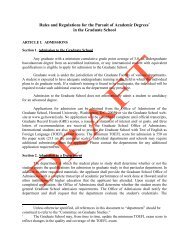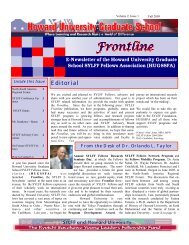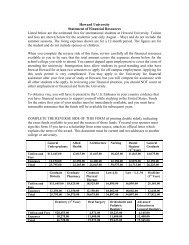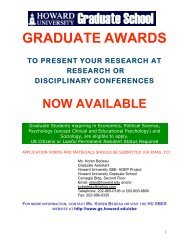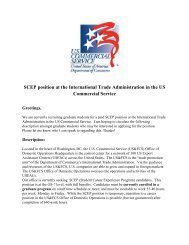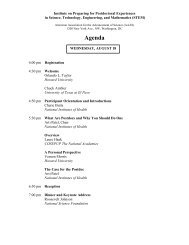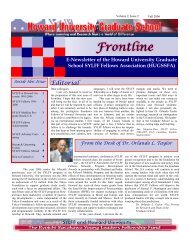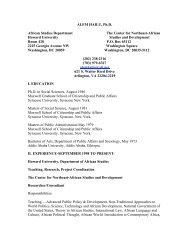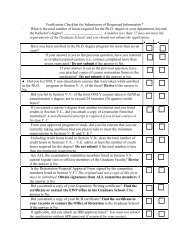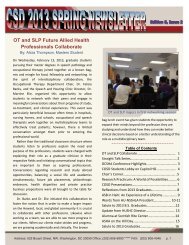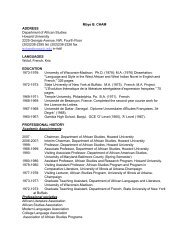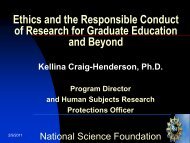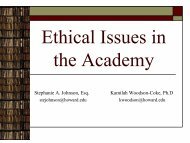Self-Study Design - Howard University, Graduate School
Self-Study Design - Howard University, Graduate School
Self-Study Design - Howard University, Graduate School
You also want an ePaper? Increase the reach of your titles
YUMPU automatically turns print PDFs into web optimized ePapers that Google loves.
Standard 2: Planning, Resource Allocation, and Institutional Renewal<br />
• Chair: Professor William Spriggs, Economics<br />
Scope of Work and Objectives.<br />
This scope of work will govern the collection or creation of plans that assess such areas as<br />
community relations, annual budgeting process, capital needs, enrollment, academic excellence,<br />
technological adeptness, unit-level resource allocation, and financial planning process. <strong>Howard</strong>’s<br />
approach for meeting Standard 2 will be informed by the Mission statement and goals of the<br />
<strong>University</strong> and the current Strategic Framework for Action. The work group will determine to<br />
what extent the <strong>University</strong> has adequate processes to plan to accomplish its mission and goals<br />
and how well the <strong>University</strong> aligns its activities at all levels (for example, technology, facility<br />
use, academic, and human resources) through a planning process. The work group will also<br />
determine how those plans then lead to a process by which assessments can be made.<br />
Major Research Questions.<br />
1. Does the <strong>University</strong> have a strategic plan, and what is the process by which the plan is<br />
developed, including:<br />
• Which stakeholders are involved in creating the plan?<br />
• What insures its alignment with the <strong>University</strong> mission?<br />
• Does the plan lead to outcomes that can be, and are, assessed?<br />
2. How does the strategic plan then lead to subsequent planning exercises by different units<br />
(those academic units that report directly to the Provost or Senior Vice President for<br />
Health Sciences and those administrative offices that report directly to a senior vice<br />
president of the <strong>University</strong>) to guide the units’ actions?<br />
3. What is the extent to which the <strong>University</strong>’s strategic plan and subsequent revisions are<br />
driven by assessment data?<br />
4. How are technology needs coordinated to accomplish goals in the strategic plan and<br />
assessed and updated in accordance with changing needs?<br />
5. What is the plan for facility use and upkeep, in the coordination of facility usage and the<br />
plan for addressing facility usage within the context of the institutional mission and<br />
priorities?<br />
6. What is the <strong>University</strong>’s academic plan, and the assessment of such plans? What is the<br />
academic unit planning process, and the enrollment management planning process and<br />
how are these decisions made to assure the adequate resources are in place to accomplish<br />
each within the context of the <strong>University</strong>’s mission and goals?<br />
7. How is the <strong>University</strong>’s human resource planning process aligned with its strategic plan,<br />
including consideration of such matters as personnel succession of key leaders, faculty<br />
retention and retirements?<br />
8. Is the current <strong>University</strong> budget adequately aligned with its mission and academic<br />
priorities?<br />
Standard 3: Institutional Resources<br />
• Chair: Dean Beatrice Adderley-Kelly, Pharmacy, Nursing, and Allied Health Sciences<br />
16



